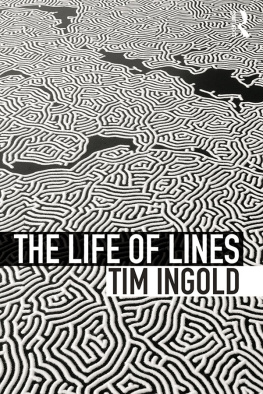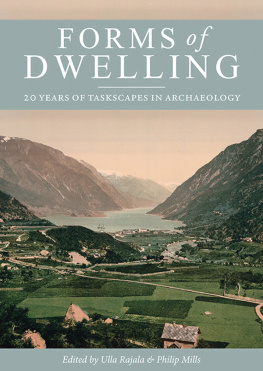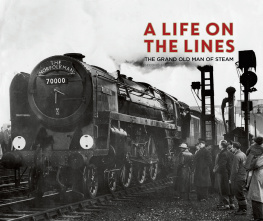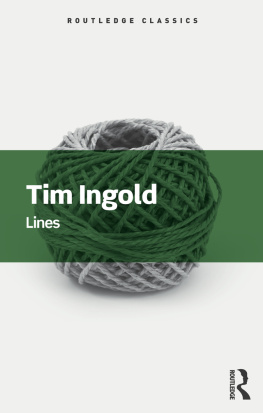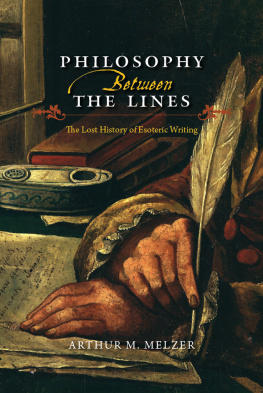The Life of Lines
In The Life of Lines Ingold develops a philosophical and ecological anthropology that is at once expansive, integrative, and inclusive. His poetic narrative interlaces bodies, minds, landscapes, topographies, and perceptions in a correspondence of lines. Taking us on a journey through movement, knots, weather, atmosphere and surfaces, he guides us to a critical conclusion: to human is a verb.
Agustn Fuentes, University of Notre Dame, USA
To live, every being must put out a line, and in life these lines tangle with one another. This book is a study of the life of lines. Following on from his groundbreaking work Lines: A Brief History, Tim Ingold offers a stunningly original series of meditations on life, ground, wind, walking, imagination and what it means to be human.
A world of life is woven from knots; not built from blocks as commonly thought. Ingold shows how knotting underwrites both the way things join with one another in walls, buildings and bodies and the composition of the ground and the knowledge we find there.
To study living lines we must also study the weather. To complement his linealogy, Ingold develops a meteorology that seeks the common denominator of breath, time, mood, sound, memory, colour and the sky. This denominator is the atmosphere.
Finally, Ingold carries the line into the domain of human life. For life to continue, he argues, the things we do must be framed within the lives we undergo. In continually answering to one another, these lives enact a principle of correspondence that is fundamentally social.
This compelling volume brings our thinking about the material world vividly back to life. While anchored in anthropology, the book ranges over an interdisciplinary terrain that includes philosophy, geography, sociology, art and architecture.
Tim Ingold is Professor of Social Anthropology at the University of Aberdeen, UK. His books for Routledge include Lines: A Brief History (2007), The Perception of the Environment (reissued 2011), Being Alive (2011) and Making: Anthropology, Archaeology, Art and Architecture (2013).
The Life of Lines
Tim Ingold

First published 2015
by Routledge
2 Park Square, Milton Park, Abingdon, Oxon OX14 4RN
and by Routledge
711 Third Avenue, New York, NY 10017
Routledge is an imprint of the Taylor & Francis Group, an informa business
2015 Tim Ingold
The right of Tim Ingold to be identified as author of this work has been asserted by him in accordance with sections 77 and 78 of the Copyright, Designs and Patents Act 1988.
All rights reserved. No part of this book may be reprinted or reproduced or utilised in any form or by any electronic, mechanical, or other means, now known or hereafter invented, including photocopying and recording, or in any information storage or retrieval system, without permission in writing from the publishers.
Trademark notice: Product or corporate names may be trademarks or registered trademarks, and are used only for identification and explanation without intent to infringe.
British Library Cataloguing-in-Publication Data
A catalogue record for this book is available from the British Library
Library of Congress Cataloging-in-Publication Data
Ingold, Tim, 1948
The life of lines / Tim Ingold.
pages cm
Includes bibliographical references and index.
1. Signs and symbols--History. 2. Writing--History. 3. Drawing--History.
I. Title.
GN452.5.I539 2015
301--dc23
2014039249
ISBN: 978-0-415-57685-7 (hbk)
ISBN: 978-0-415-57686-4 (pbk)
ISBN: 978-1-315-72724-0 (ebk)
Contents
Figures
Tables
1 January 2014: feeling a bit depressed by the relentless passage of time, as I often do on New Years Day, I cheered myself up by writing in my notebook: Today I am going to get back to work on The Life of Lines. Then I went for a walk in the hills and thought about it. And that was that. Life intervened, as it always does, in the form not of opportunities to write my lines, but of the incessant demands of academic employment. I had been meaning to complete the book for years, and had been accumulating bits and pieces of writing with a view to putting them all together once a suitable moment would arrive. But it never did. Days, weeks and months ticked by, and I was still no closer to composing the book than when the year began.
Indeed almost seven years had elapsed since I first ventured into print on the subject of lines. My book Lines: A Brief History was published in 2007. Yet even before the ink was dry on the manuscript, I already knew that I would have to write some sort of sequel. Not knowing exactly what it would be about, I filed it in my head as Lines 2. All I knew was that it would have something to do with lines and the weather. For I had found, rather to my surprise, that thinking about lines always brought thoughts about the weather in its wake, and vice versa. Why was that, I wondered? Perhaps it only proved that I had completely lost the plot. Any level-headed reader, for whom the idea that an anthropologist can study lines is hard enough to swallow, would surely conclude that to take off into the atmosphere is to go completely off the rails. What business has an anthropologist encroaching on territory that rightfully belongs to the science of meteorology, or maybe to students of aesthetics? These doubts nagged at me too, and yet the idea of a unified field of linealogy and meteorology would not let me go.
An opportunity to contribute to the inspirational series of seminars that anthropologist and ex-architect Trevor Marchand convened at the School of Oriental and African Studies in London, in 2007, and to the subsequent volume, provided me with an excuse to begin to set my thoughts on paper, and a Professorial Fellowship funded by the UK Economic and Social Research Council for the three years 20058 afforded me a window of time to do so. Chopped up, redistributed and enlarged, much of the material from that paper, which was called Footprints through the weather-world, has found its way into this book, particularly in the first and second parts. Two subsequent developments, however, led me to realise that the issue of lines and the weather would have to be part of a wider investigation.
One of these was a call issued by the Leverhulme Trust, in 2013, for proposals for a programme of research on the theme of the nature of knots. With my interest in lines, this was not a chance I could pass up, and with colleagues from the University of St Andrews and University College London I set about designing a programme under the title of Knotting Culture. Though the proposal eventually fell by the wayside, I have the Leverhulme Trust to thank for more than setting me thinking about the knot, as a principle of coherence, in ways that laid the foundations for the first part of this book. For after three punishing years as Head of the School of Social Science, here at the University of Aberdeen (200811), the Trusts award of a Major Research Fellowship for the following two years, 201113, gave me the breathing space I needed to develop my ideas. The long book that I had originally intended to write during the Fellowship, which would have been called Bringing Things to Life, became two shorter books instead. The first, Making, was completed in 2012 and published in the following year. The second is the book now in your hands.
The other development that has borne fruit in this book, especially in the third part, was the result of a fortuitous set of circumstances all of which had something to do with walking. One was hearing the writer Andrew Greig read from his work at the Festival of Walking, Writing and Ideas, held at the University of Aberdeen in August 2012. Among those present in the audience was the artist, writer and curator Mike Collier, from the University of Sunderland. In the following year, Mike organised a wonderful exhibition at Sunderland on the theme of walking, and a conference to go with it, both entitled Walk On. It was a privilege for me to be invited to contribute to the conference, and I have reworked the paper I wrote for it, called The maze and the labyrinth: walking and the education of attention, into several chapters of this book. The other crucial circumstance was attending another conference on walking, held in September of the same year (2012) to conclude the Sideways Festival, in which a group of hardy souls had spent a month walking the length and breadth of Belgium, along its lesser known tracks and trails. I had not been among them, but at the conference a talk by the philosopher of education Jan Masschelein, whom I had never encountered before, made me sit up. The ideas about walking and education that he was putting forward were to my ears at least quite revolutionary, and they have done much to shape my subsequent thinking, not least in this book.
Next page
